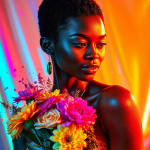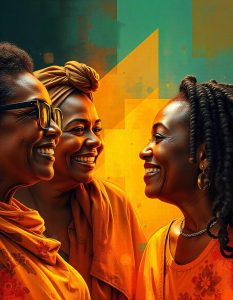1 The Intentional Act of Changemaking

With vigor and robust enthusiasm, playwrights Suzan-Lori Parks, Velina Hasu Houston, Aishah Rahman, Dael Orlandersmith, and Cheryl West advance one’s understanding of motherhood, especially for Black women. With keen awareness and shrewd, mature observations of society, each of these women playwrights diminishes the distorted perceptions of Black women as disconnected or excluded from the complex considerations of their humanity. Instead, these gifted, conscious, and instinctive creators use their critical dramas to restore Black women’s and Black mothers’ connection to a rich and dynamic human reality. These playwrights include Black mothers in the complex human drama of life in all its truth through depictions of home, family, children, relationships, society, church community, and work—which are all critical components of unity and progress for the African American community.
The five plays presented in this collection of essays chart a contemporary Black Motherhood Aesthetic that reveals, identifies, and protects the nuances and experiences of Black female characters who are raising children. By writing these plays, the playwrights offer a transformative contribution for the characters. They allow the characters (who are mostly Black women and girls) to tell their own stories. This offers audiences, actors, and directors cognizance of and insights into these characters’ deepest vulnerabilities, experiences, and exposures. These characters speak truthfully and revealingly through the combined chorus of their storytelling. Readers of this book will experience this personal storytelling—which is, in and of itself, an act of courage, rebellion, and justice seeking. The Black Motherhood Aesthetic gives shape and context to these storytellers and their stories. It also highlights the contributions that the playwrights make by writing these plays. The Black Motherhood Aesthetic places the full and ennobling humanity of Black women on display to expose the array of their human experiences, from self-determination, trauma, and bravery to self-preservation and jubilation.
We argue that the plays analyzed in this collection continue the work of Black female playwrights who have, across the years, rooted their works in a commitment to community, equity, and community wellness. The plays featured in this collection (written between 1987 and 1999) assert a Motherhood Aesthetic that depicts things as they are, not as popular myth, self-serving delusion, or cultural romance would have them. The existence of these plays changes the perception of Black mothers in relationship to economics, health, mental health, social determinants, and personal outcomes. The “realness” and realism of these plays influence and change the reality the playwrights and characters describe.
Gap in Dramatic Studies

Since the 1986 publication of Margaret Wilkerson’s groundbreaking anthology 9 Plays by Black Women, critics of African American women’s drama have celebrated the unique perspective of contemporary playwrights who “reveal the complex, interior landscape of Black women’s lives while at the same time looking outward and commenting on the world which impinges on their existence.”[1] By default and intention, Black female dramatists “stretch the arts of the theatre to fulfill the demands of their part of the world, both shaped by and shaping the forces of society.”[2] This notion echoes in nearly every anthology and study of plays written by Black women of the past four decades. Sydné Mahone, editor of Moon Marked and Touched by Sun (1994), argues that the inclusion of a Black female context reforms drama by creating a distinctive body of material that centers the historical experience of Black women in the United States.
Subsequent texts, like Contemporary Plays by African American Women: Ten Complete Works (2015), also center the historical experience of Black women in the United States. Specifically, this anthology gives space for the canon to include both widely known and lesser-known Black female playwrights. Editor Sandra Adell included ten plays that represent the diversity of the African American experience. These ten playwrights, each of them gifted in their respective use of parody and satire, capture themes related to dating and relationships, high-society identity, family, death, forbidden love, and other human experiences. Like Moon Marked and Touched by Sun, Contemporary Plays by African American Women: Ten Complete Works features for its readers many of the thematic preoccupations examined in the plays featured in this book. However, it does not identify trends or theories across the panoply of plays.
The Motherhood Aesthetic in Black American Plays fulfills a particular need in that it offers what other books on contemporary African American women’s drama do not—a cohesive framing of plays that reveals specific thematic patterns related to Black female motherhood. Namely, these patterns relate to discussions of physical and psychological safety in the community, wholeness of the mother, and stability and support of the Black family and its children. This book contends that embedded in the work of Suzan-Lori Parks, Dael Orlandersmith, Aishah Rahman, Cheryl West, and Velina Hasu Houston (who is included in this group for the first time) there is an aesthetic that is traceable through the motif of motherhood. “This book contends that embedded in the work of Suzan-Lori Parks, Dael Orlandersmith, Aishah Rahman, Cheryl West, and Velina Hasu Houston . . . is an aesthetic that is traceable through the motif of motherhood.” Suzan-Lori Parks, for example, writing on recurring pregnancy, uses In the Blood (1999) to draw our attention to the ways in which multiple births combined with low income complicate a woman’s existence. Cheryl West, writing of HIV and AIDS in Before It Hits Home (1991), exposes a woman’s inability to cope with the presence of a terminal infectious disease in her household. Aishah Rahman weaves a woman’s narrative of disengagement with her family into a story of loss and redemption in The Mojo and the Sayso (1987), while Dael Orlandersmith showcases the generational reverberations of violence and abuse in girls’ lives in Monster (1996). Taking these matters a step further, Velina Hasu Houston offers Alabama Rain (1992) to comment on unsafe homes and marriages in the lives of underage girls. Through the creative, bold genius of these Black women playwrights, the protagonists in these plays offer perceptions of motherhood that are both nuanced and well developed and that have become unique and prescient archetypes of twenty-first-century Black motherhood.
Born of care and urgency—and beyond symbolic gesture—each play bears witness to the Black woman as lead character in the functionality of her life; and, each play confirms the Black Female Motherhood Aesthetic as a valorous act, rather than as a philosophical concept only. These plays, all distinctively written by Black female playwrights, center stage the mother characters explicitly and the Black mother characters specifically. This“These plays, all distinctively written by Black female playwrights, center stage the mother characters explicitly and the Black mother characters specifically.” intentional act of change-making ensures that Black culture is creatively portrayed in its context by members of its own community, thus better safeguarding it.
To commemorate the unique depth and breadth of work by Black female playwrights in the United States and in American culture is to know for certain that a highway has been “throw[n] up through de wilderness” by which a new generation of Black female playwrights can portray, write about, and explore the complexities of life in America.[3]
The Benefits of a Digital Format
Because the plays treated in this book are often misunderstood, the authors (Rogers and Walker) have taken their time to decode them and offer reading tools for audiences. Their expectation is that these audiences comprise theatre specialists, non-specialists, students, and professors/teachers, among other spectators.
The authors are launching this text in a digital format because it meets researchers where they are (i.e., online), makes the dramatic theories accessible to broader communities (via the Internet), and celebrates literary and technological advancements beyond the flat text. By including hyperlinks and embedding digital content, the authors increase accessibility to these cultural materials. Moreover, these inclusions promote the use of creative methodologies in textual preservation and analysis, which ultimately facilitates a more nuanced understanding of literary texts. Although the authors are conscious of the discourse surrounding AI-generated images, the use of such images throughout this book is in line with the authors’ intention to advance digital scholarship, digital humanities, and digital creation.
The authors intend this book to have wide availability for classroom use as a compendium for staging, studying, reading, or viewing the plays it discusses. This digital tool also has broad applicability for theatre lobbies, where playgoers might read a chapter or two before or after a production or during intermission. The authors are certain that the project will help non-Black directors (and Black ones, too!) understand the dramatic aesthetics of Black female playwrights.



